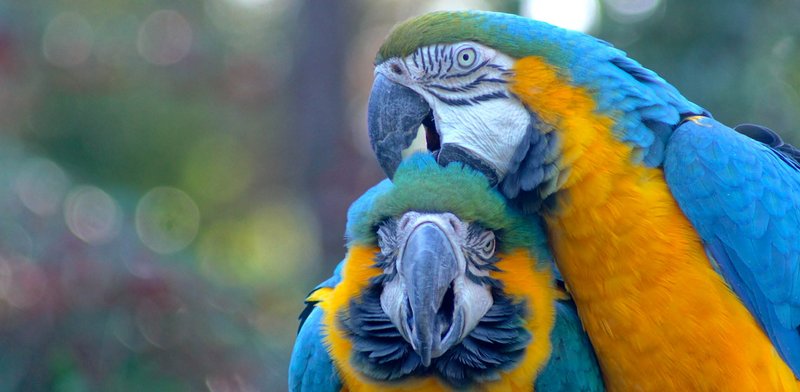
You might be wondering how these birds manage to survive against the odds. Just like us, they rely on a mix of instincts, learned behaviors, and physical characteristics to navigate their world. In this article, we’ll dive deep into the incredible ways blue-and-yellow macaws adapt to their environment, from their social structures to their feeding habits and even their communication styles. So, grab a cup of coffee, and let’s explore these amazing birds together.
Bright Colors: A Double-Edged Sword
One of the most eye-catching features of blue-and-yellow macaws is their vibrant plumage. Their bright colors serve a few important purposes. First and foremost, camouflage plays a vital role in their survival. While their feathers are striking to us, they blend surprisingly well into the dappled sunlight filtering through the trees. This makes it harder for predators to spot them.
But you might also be curious about how these colors help in social interactions. Blue-and-yellow macaws are highly social creatures, often seen flying and foraging in groups. Their bright feathers serve as a way to communicate with each other. A flash of blue or yellow can signal excitement, alertness, or even a readiness to play. So, while their colors might draw your attention, they also play a crucial role in the macaw’s complex social life.
Diet and Foraging Strategies
Now, let’s talk about food. Blue-and-yellow macaws are primarily fruit-eaters, but they have a varied diet that includes seeds, nuts, and even flowers. Their strong, curved beaks are perfectly designed to crack open tough nuts and seeds, allowing them to access nutrition that other birds can’t. It’s like having a toolbox designed specifically for their unique meal preferences!
Foraging is a group effort for these birds, and they often work together to find food. While one macaw might scout for the best fruits, others keep watch for predators. This teamwork not only ensures they find the best meals but also keeps them safe. Honestly, this social foraging strategy reflects a strong community bond that makes their survival even more effective.
Intelligent Communication
Blue-and-yellow macaws are known for their loud, piercing calls. These vocalizations serve more than just a purpose of being heard over long distances; they’re a vital part of their social interactions. Their ability to communicate allows them to maintain social bonds and alert each other about potential dangers. Imagine being at a party and needing to warn your friends about something—communication is key!
Fun fact: these birds can learn to mimic sounds and phrases. In captivity, some have picked up on human speech! This adaptability in communication highlights their intelligence and ability to learn from their environment. Being able to adapt their communication skills significantly enhances their chances of survival. Here’s the thing—whether it’s a call to gather or a warning of danger, effective communication is essential for their thriving community.
Building Nests in Unique Locations
When it comes to nesting, blue-and-yellow macaws are strategic. They typically build their nests in the hollows of tall trees, providing a safe space for their young away from predators. This choice of nesting location is an adaptation to their environment. By nesting high up, they can avoid ground-based threats.
You might wonder why they prefer hollow trees. These trees offer protection from rain and temperature extremes while also providing insulation for their chicks. Building nests in these sheltered locations ensures the safety and survival of their young, allowing them to grow strong before they’re ready to fledge.
Social Structures and Group Dynamics
Blue-and-yellow macaws are some of the most social birds in the animal kingdom. They often form tight-knit pairs or small flocks, highlighting the importance of their social structures. Living in groups provides numerous advantages, such as increased protection from predators and enhanced foraging success.
Their social interactions are fascinating. You might catch them preening one another or engaging in playful antics, which strengthens their bonds. This social behavior not only builds relationships among the group but also fosters a sense of community, crucial for their overall well-being. You could say that in the world of blue-and-yellow macaws, teamwork really makes the dream work!
Environmental Challenges and Threats
Despite their amazing adaptations, blue-and-yellow macaws face significant challenges in the wild. Habitat loss due to deforestation is one of the biggest threats to their survival. As their homes are destroyed, they lose access to food and nesting sites. It’s like moving to a new city without knowing where to find your favorite diner!
Additionally, they are often targeted by poachers for the illegal pet trade. This not only affects individual birds but can disrupt their social structures and reproductive success. Conservation efforts are crucial to protect these beautiful creatures and their habitats. Understanding the threats they face helps us appreciate the importance of supporting initiatives that aim to preserve the natural environments in which they live.
Blue-and-yellow macaws are truly remarkable birds, showcasing an incredible array of adaptations that allow them to thrive in their natural environments. From their striking colors to their intelligent communication and social structures, they embody resilience and adaptability. Their ability to navigate the challenges of their surroundings makes them one of nature’s standout species.
As we continue to learn more about these beautiful creatures, it’s important to advocate for their protection. By supporting conservation efforts and raising awareness about their challenges, we can help ensure that blue-and-yellow macaws continue to soar through the skies for generations to come. Let’s celebrate these amazing birds and the unique ways they adapt to their world!
